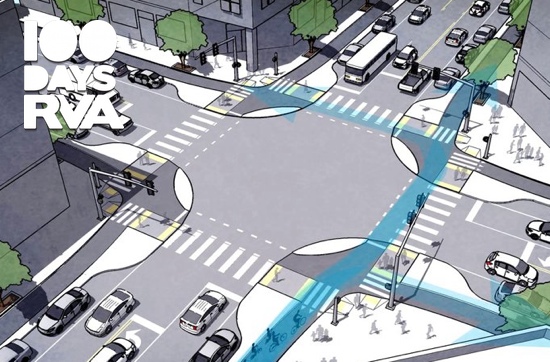Day #027: Safer intersections
Have you ever tried crossing Monument Avenue at Lombardy?

Inspired by Michael Bierut’s 100 Day Project, 100 Days to a Better RVA strives to introduce and investigate unique ideas to improving the city of Richmond. View the entire project here and the intro here.
- Idea: Square out intersection corners, increase pedestrian crossing islands, go on a road diet, and eliminate roundabouts.
- Difficulty: 2 — VDOT has plenty to say about road design that could stymie future changes in Richmond.
Roads, bike lanes, and sidewalks are the arteries of Richmond. Tens of thousands of people work their ways through the city by car, bus, bike, and foot every day. All of these people and all of these modes of transportation interact in countless ways.
Richmond’s intersections are under equipped and poorly designed to help buses, cars, bikes, and pedestrians interact safely and efficiently. Future road maintenance and renovations should make stronger efforts to square out the corners of intersections, use more pedestrian crossing islands, increase road diets, eliminate roundabouts, and limit pedestrian exposure.
Efforts to increase “bikeability” are in full force in Richmond. I applaud the efforts of those working to build protected bike lanes and the Floyd Avenue “RVA Bike-Walk Street.” This is quite simply the future.

Pedestrian deaths and accidents aren’t a daily affliction plaguing the streets of Richmond,
What makes a good intersection? There are only two metrics that matter when it comes to intersection design: safety and efficiency. Roads haven’t always met these two goals, but really smart people are starting to improve safety for everyone and efficiency for pedestrians and cyclists.
In 2012, the Federal Highway Administration released nine “Proven Safety Countermeasures.” Four are directly related to intersections: medians and pedestrian crossings, pedestrian hybrid beacons, road diets, and roundabouts. Also Suburban Nation: The Rise of Sprawl and the Decline of the American Dream, makes the case for squaring out the corner of intersections and limiting pedestrian exposure.
— ∮∮∮ —
The intersection at Monument Avenue and Lombardy may be the worst intersection I have seen in the entire world.


Squaring out intersection corners
Road safety starts with design that forces drivers to do things instead of asking them to do so. Narrower lanes and sharper turns are significantly more effective than any signage. Rounded corners like the ones in the image above allow cars to fly around corners at high speeds, they encourage people to turn right on red without coming to a complete stop, and they hide pedestrians behind parked cars. The flowing circles of Monument Avenue are nice to look at, but they limit access to pedestrians.
The best view of one of Richmond’s most historic streets should not be from an automobile. Instead of pseudo-roundabouts and jumbled intersections, Richmond could square off all of the intersections and create viewing areas/parks for each monument.
Medians and pedestrian crossing islands
The above intersection has medians, but the exposed sections of roads limit their effectiveness. Every lane for turning should be further separated by medians for pedestrian crossing. These can be used as islands of refuge in addition to forcing cars to turn and face pedestrians.
According to the FHA, “more than 80 percent of pedestrians die when hit by vehicles traveling at 40 mph or faster while less than 10 percent die when hit at 20 mph or less” and “midblock locations account for more than 70 percent of pedestrian fatalities.” Every inch of protection and every extra tap of the brakes means more lives saved.
Road diets
Adding lanes does not significantly reduce traffic in the long run. This study (which changed my life), empirically proves that “every 1% increase in new lane-miles generated a 0.9% increase in traffic in less than five years.”
This is because of “traffic inducement” or “induced demand” and it’s why most cities in America have wasted millions of dollars in development since the end of WWII.
Lane diets take four lane roads and reduce them to two lanes of traffic and a shared turn lane in the middle. This opens up space for bike lanes, pedestrian crossing islands, wider sidewalks, and more parking.
Roundabouts
Roundabouts are currently very popular. They “limit serious accidents” and provide an island of refuge for pedestrians. Two problems: all accidents are serious for cyclists/pedestrians and islands of refuge can be created without roundabouts.
I’ll concede that roundabouts limit idling cars which is better for the environment, but all statistics for roundabouts are in relationship to what I consider poorly designed intersections. The FHA even admits that “the safety performance of all-way stop control is comparable to roundabouts (per the HSM).”
Roundabouts are dangerous for cyclists, provide no advantage to pedestrians, and are highly inconvenient for the blind and people who use wheelchairs.
— ∮∮∮ —
Even more could be done to increase the safety of this specific intersection: add pedestrian-friendly signals, improve the drainage around wheelchair ramps, increase the lighting so crossing at night is less of a nightmare. These are complaints about just one intersection in Richmond.
If Richmond focuses on making these improvements to its intersections for the next decade, RVA will undoubtedly be a better and safer place for automobiles, cyclists, and pedestrians.
Photo from: Nick Falbo’s Protected Intersections for Bicyclists
Love this idea? Think it’s terrible? Have one that’s ten times better? Head over to the 100 Days to a Better RVA Facebook page and join in the conversation.
-
Check out what the next level, bike-friendly, protected intersection looks like.
-
15 pedestrians died in crashes between 2009 and 2013
-
Maybe not worse than in India where riding an auto-Rickshaw around the block is easier than crossing the street–then again, you’re not fighting a false sense of comfort and safety in Bangalore.
-
Recommend this
on Facebook -

Report an error
-

Subscribe to our
Weekly Digest





There are no reader comments. Add yours.